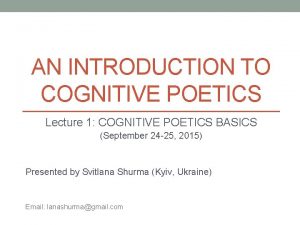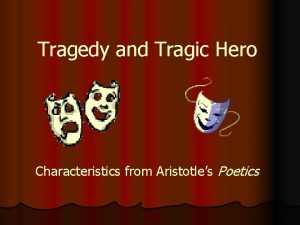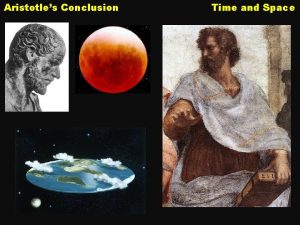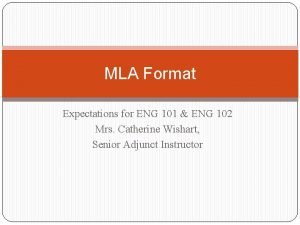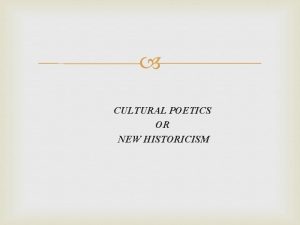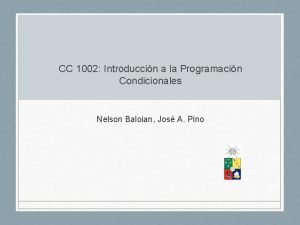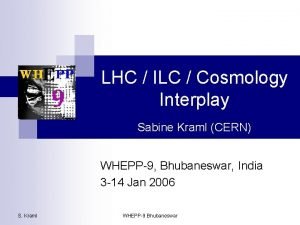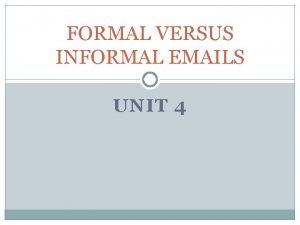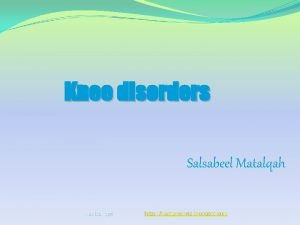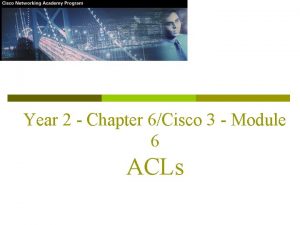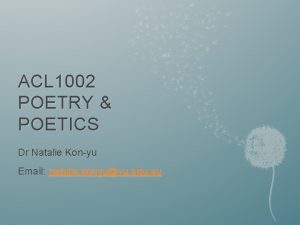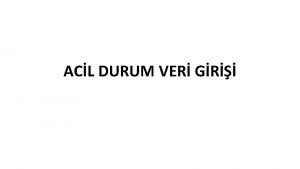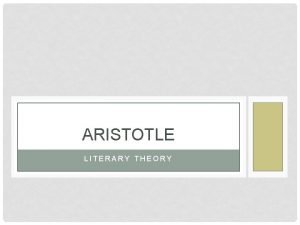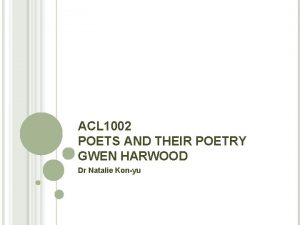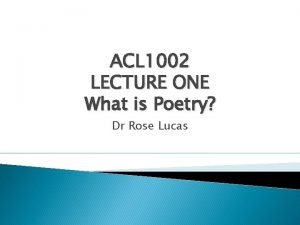ACL 1002 POETRY POETICS Dr Natalie Konyu Email


















- Slides: 18

ACL 1002 POETRY & POETICS Dr Natalie Kon-yu Email: natalie. konyu@vu. edu. au Semester 2, 2011

Appreciating poetic form — identifying poetic formality. Do the form and the formal elements of a poem affect our understanding of it? • Useful background reading for this lecture: ‘Rhythm, Form, and Metre, ’ appendix to Leonard’s Seven Centuries of Poetry in English. Some fundamentals of form in spoken poetry (as distinct from graphic poetry, e. g. concrete poetry): • Sound quality; • Rhythm; • Duration; and • Semantics. Examples of what English-language poets have done with form and formality in their works.

Concrete Poetry We will be looking at concrete poetry later in the semester, but there is currently an exhibition of concrete poems at the Heide. http: //www. heide. com. au/exhibiti ons/born_to_concrete? exhib=54

How does the shape of this poem influence its meaning?

Form and formality Think of how forms are used in daily life: Forms we have to fill in (e. g. change of enrolment forms). Builders use moulds called forms for the concrete on building sites. To form something is to be its creator (e. g. many people believe that a god or divine power formed the world). When we talk about ‘forms’ of poetry, we mean classifying poems according to certain ‘formal’ elements they have or lack. E. g. sonnet, ballad, rap, haiku, epic, blank verse, etc. When we talk about formality in poetry, we mean the

Some conventional poetic forms Sonnet Villanelle Ballad Haiku others? What do conventional forms prevent you from doing?

The Sonnet is one of the more rigid poetic forms – one of the earliest forms established in English. Comes from the Italian (little sound/song) In the middle ages developed by the great Italian poets including Dante and Petrarch – the latter establishing it as a major poetic form. A number of English poets wrote sonnet sequences: Sidney; Spenser; Shakespeare – all very centrally about love and passion. Often blazons, a poetic catalogue of a woman’s body parts. E 17 th century poets seemed less interested in the love theme; Donne in religious themes and Milton less specific, occasional themes. Virtually extinct until they were resuscitated in the Romantic period and again in the Victorian age Contemporary poets use the sonnet but explore the

Sonnet CXXX (Sonnet 130) My mistress' eyes are nothing like the sun; Coral is far more red, than her lips red: If snow be white, why then her breasts are dun; If hairs be wires, black wires grow on her head. I have seen roses damasked, red and white, But no such roses see I in her cheeks; And in some perfumes is there more delight Than in the breath that from my mistress reeks. I love to hear her speak, yet well I know That music hath a far more pleasing sound: I grant I never saw a goddess go, My mistress, when she walks, treads on the ground: And yet by heaven, I think my love as rare, As any she belied with false compare.

Form of Sonnet 130 �My mistress' eyes are nothing like the sun; (a) Coral is far more red, than her lips red: (b) If snow be white, why then her breasts are dun; (a) If hairs be wires, black wires grow on her head. (b) I have seen roses damasked, red and white, (c) But no such roses see I in her cheeks; (d) And in some perfumes is there more delight (c) Than in the breath that from my mistress reeks.

Form and meaning �In this poem, we see that there is a regular rhyming pattern (a, b, a, b). �The pattern is repeated three times before changing (a, b, a, b; c, d, c, d; e, f, e, f; gg). �Why does the rhyme change in the last couplet? �What does the rhyme scheme have to do with the poem’s meaning?

Rhyme and Rhythm �As Ian mentioned last week, rhyme was established in poetry so that poems could be memorised and performed. �As we can see, the rhyme at the end of each line, also helps us to establish the meaning of the poem – the departure from a, b, a, b to gg in the Shakespearian Sonnet tells us that special significance is to be paid to those last two lines. � When we read the poem aloud, we also notice there is a particular rhythm to the poem

Finding form in poetry — I Sound Quality Sounds that resonate identically or similarly: E. g. rhyme, assonance, alliteration, anaphora. Sounds to which we attach pre-conscious importance: E. g. bright sounds, loud sounds, gentle sounds, watery sounds, violent sounds, tender sounds. Sounds that convey particular meaning (especially onomatopoeia and poetic irony). A superb use of qualities of sound in poetry is Auden’s ‘Old People’s Home, ’ from the Discussion poems.

Finding form in poetry — II Rhythm http: //prosody. lib. virginia. edu/materials/poems/sonn et-73/ In English, we tend to mark the rhythm of speech with emphasis (i. e. volume increases). We do not much use length of syllable (as Greek and Latin do) or tone (as many east Asian languages do). So the rhythm in English comes from our grammar of louder and quieter syllables. It is possible to ‘scan’ a line of verse, as Leonard’s appendix shows, counting its syllables and tracking rhythms of stress/unstress (as well as more complex forms). If a poem’s rhythm follows formal rules, we call that a metre.

Finding form in poetry — III Duration We hear a poem as a series of sounds in time — quite different from reading a block of letters forming words on a pile of pages. Our aural experience of listening and speaking is more time-conscious than the visual experience of reading and writing. (Notice how agitated audiences get when someone talks for too long. ) Poetry can achieve major effects through its use of duration — duration of the poem overall and duration of segments within the poem. E. g. epic poetry builds on the time it takes ‘to tell a good story properly. ’

Finding form in poetry — IV Semantics Some poetic forms require particular semantics: E. g. An elegy always expresses a sense of loss. E. g. A traditional haiku is about a natural phenomenon, and alludes to a season. None is travelling Here along this way but I, This autumn evening. Won't you come and see loneliness? Just one leaf from the kiri tree.

Finding form in poetry — IV Semantics (contd) Once we know the sound, rhythm, and time techniques of poetry lend themselves to particular ways of forming meaning, we can see poets start to play with those meanings as well: E. g. poems that pretend to say one thing (their formally expected meaning) but really say another instead or as well (poetic irony). E. g. poems that pass comment on their own formal characteristics. One of the cleverest semantic manipulations of form in poetry is Shakespeare’s ‘Sonnet XVIII. ’

A final word on ‘formality’ Whatever code of rules we’re following and/or breaking, they inherently represent a formality: Following rules comes across as trying to do it ‘the right way. ’ Breaking rules reads as an effort to change the way things get done. Inventing new rules can come across as both visionary and arrogant, depending on your audience’s point of view. In other words, remember that poetic formality is a question of style — even in conservative periods of poetry composition.

http: //www. bartleby. com/101/357. h tml How does this poem conform to our expectations? How does it confront or challenge our expectations?
 What is cognitive poetics
What is cognitive poetics Poetics of culture
Poetics of culture Aristotle poetics tragic hero
Aristotle poetics tragic hero Conclusion of aristotle
Conclusion of aristotle Aristotle poetics mla citation
Aristotle poetics mla citation Cultural poetics
Cultural poetics Elif capítulo 1002
Elif capítulo 1002 Kaon cp violation
Kaon cp violation Tübitak 1002 ne kadar sürede sonuçlanır
Tübitak 1002 ne kadar sürede sonuçlanır 1001 1002 1003 1004
1001 1002 1003 1004 Tübitak 1004 bursiyer ücretleri
Tübitak 1004 bursiyer ücretleri Email format formal
Email format formal Acl test
Acl test Acl okul
Acl okul 1-800-677-1116
1-800-677-1116 Acl antibody
Acl antibody Acl ppp
Acl ppp Keats acl
Keats acl Acl in ccna
Acl in ccna
